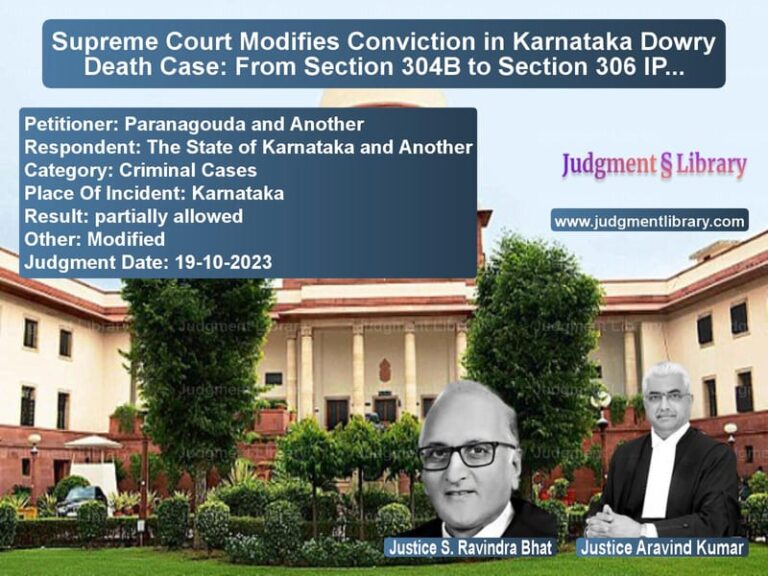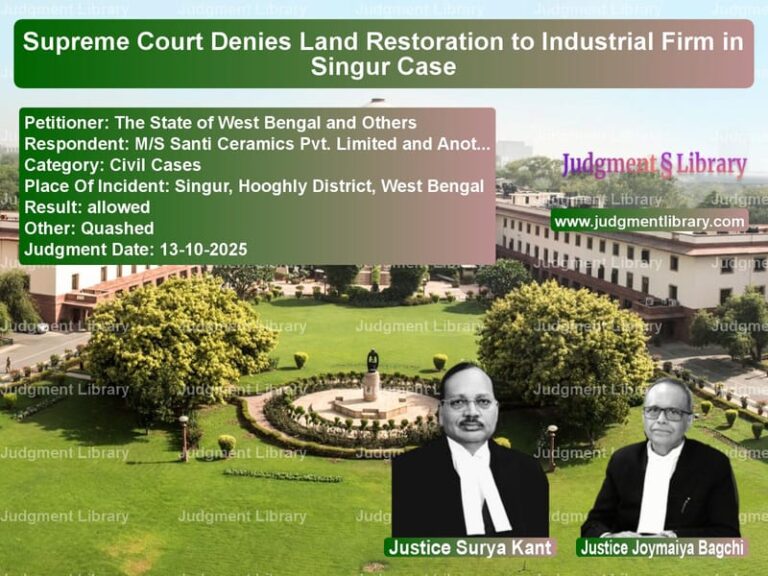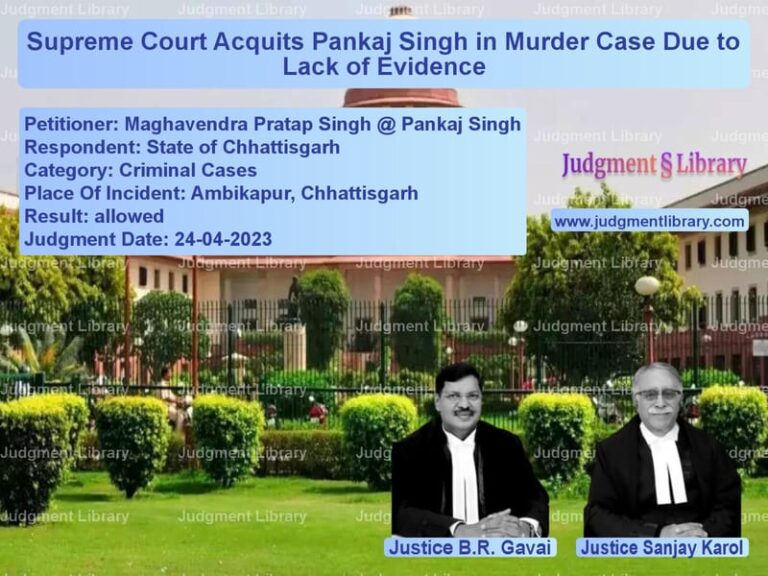Electricity Tariff and Foreign Exchange Rate Variation: Supreme Court’s Key Ruling
The Supreme Court of India, in a significant ruling, addressed the issue of Foreign Exchange Rate Variation (FERV) and its apportionment in the case of Power Grid Corporation of India vs. Tamil Nadu Generation and Distribution Co. Ltd. & Ors.. This case primarily focused on whether FERV should be apportioned between debt and equity after it has been calculated and added to the capital cost of power projects.
The judgment also involved a similar appeal, NTPC Limited vs. Central Electricity Regulatory Commission & Ors., concerning the methodology adopted by regulatory authorities in the power sector to determine the distribution of FERV among stakeholders.
Background of the Case
The dispute arose due to the Central Electricity Regulatory Commission (CERC) determining a methodology for FERV capitalization, which was later affirmed in a review petition. The case was taken up by the Appellate Tribunal for Electricity (APTEL), which ruled that while FERV should be calculated as part of the capital cost, it should only be apportioned with respect to debt liability.
The power transmission companies challenged this ruling, arguing that FERV should be apportioned between both debt and equity in a standard ratio. This contention led to the appeals before the Supreme Court.
What is FERV?
FERV is a crucial financial mechanism used in the power sector. It allows utilities to pass on liabilities or gains from foreign exchange fluctuations to the beneficiaries of the power supply in a staggered manner. This ensures financial stability for power generators and transmission companies, as they frequently engage in foreign currency transactions for equipment and infrastructure development.
Arguments Presented
Arguments by the Appellant (Power Grid Corporation of India and NTPC)
The learned counsel representing the appellants argued:
- FERV is added to the capital cost as a whole and not individually to debt or equity.
- Once included in the capital cost, FERV should be divided between debt and equity based on the normative debt-equity ratio.
- Historically, FERV has always been apportioned this way, and the current decision by APTEL deviates from established practice.
Arguments by the Respondents (Tamil Nadu Generation and Distribution Co. Ltd. and CERC)
The respondents countered these claims, arguing:
- The Electricity Regulatory Commissions Act, 1998, was enacted to eliminate such practices and ensure fairness in tariff determination.
- The applicable regulations do not provide for apportioning FERV in any specific ratio.
- FERV liabilities should be recovered directly from the beneficiaries without requiring capitalization.
- The appellants were seeking to capitalize FERV as per their convenience without statutory backing.
Supreme Court’s Observations
The Supreme Court meticulously analyzed the existing legal framework, industry practices, and the orders of the CERC and APTEL. The Court highlighted the following points:
- There was no substantial question of law in the appeal, as FERV apportionment is an issue of regulatory policy rather than legal interpretation.
- Regulation 1.13(a) of the Central Electricity Regulatory Commission (Terms and Conditions of Tariff) Regulations, 2001, does not explicitly mandate the apportionment of FERV in any specific manner.
- Once FERV is calculated, it can be recovered directly from the beneficiaries under Regulations 1.3 and 1.7, without requiring an approval petition before CERC.
- Given the purpose of the Electricity Regulatory Commissions Act, 1998, the court should not interfere with a framework that was designed to promote efficiency and financial discipline in the power sector.
Key Judicial Excerpts
While delivering the judgment, the Supreme Court provided critical insights:
“The present question regarding the apportionment of FERV between debt and equity is not a question of law, much less a substantial question of law.”
“The Act was introduced to reform the power sector, eliminating irrational tariffs and improving financial health. Any deviation from the established regulatory framework should be addressed by the concerned authorities and not the judiciary.”
Final Judgment
Based on these observations, the Supreme Court dismissed the appeals, stating that:
- There was no legal requirement to apportion FERV between debt and equity.
- Any variation in FERV apportionment would unfairly impact consumers, who might be forced to bear the burden of past transactions.
- The methodology adopted by the CERC and APTEL was consistent with the objectives of the Electricity Regulatory Commissions Act.
Implications of the Judgment
This judgment has far-reaching implications for the Indian power sector:
- Regulatory Stability: The ruling upholds the authority of regulatory commissions in determining cost structures for power companies.
- Consumer Protection: The judgment ensures that any liability arising from foreign exchange fluctuations is managed within the regulatory framework without burdening consumers unfairly.
- Judicial Restraint: The Court emphasized the need to respect regulatory decisions, reducing judicial intervention in matters of economic and technical policy.
Conclusion
The Supreme Court’s decision in this case underscores the importance of regulatory compliance and financial prudence in the power sector. By upholding the methodology adopted by CERC and APTEL, the Court reinforced the principle that financial decisions concerning power tariffs should remain within the purview of specialized regulatory bodies.
As India continues to expand its power infrastructure and integrate foreign investments into the sector, this ruling sets a benchmark for how foreign exchange variations should be handled, ensuring transparency and economic stability in the energy market.
Petitioner Name: Power Grid Corporation of India.Respondent Name: Tamil Nadu Generation and Distribution Co. Ltd. & Ors..Judgment By: Justice N.V. Ramana, Justice Mohan M. Shantanagoudar, Justice Indira Banerjee.Place Of Incident: New Delhi.Judgment Date: 09-05-2019.
Don’t miss out on the full details! Download the complete judgment in PDF format below and gain valuable insights instantly!
Download Judgment: Power Grid Corporati vs Tamil Nadu Generatio Supreme Court of India Judgment Dated 09-05-2019.pdf
Direct Downlaod Judgment: Direct downlaod this Judgment
See all petitions in Corporate Compliance
See all petitions in Bankruptcy and Insolvency
See all petitions in unfair trade practices
See all petitions in Judgment by N.V. Ramana
See all petitions in Judgment by Mohan M. Shantanagoudar
See all petitions in Judgment by Indira Banerjee
See all petitions in dismissed
See all petitions in supreme court of India judgments May 2019
See all petitions in 2019 judgments
See all posts in Corporate and Commercial Cases Category
See all allowed petitions in Corporate and Commercial Cases Category
See all Dismissed petitions in Corporate and Commercial Cases Category
See all partially allowed petitions in Corporate and Commercial Cases Category







